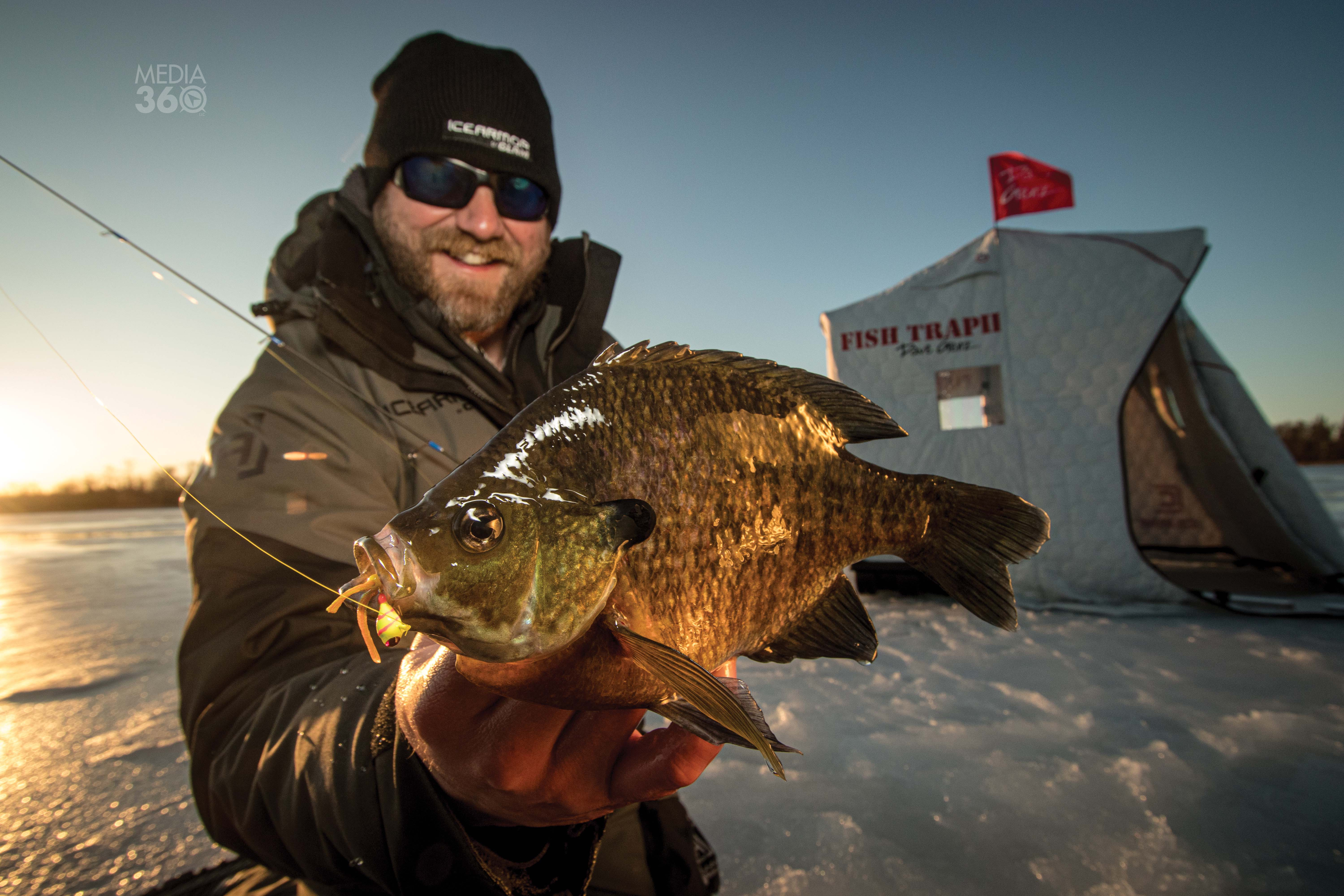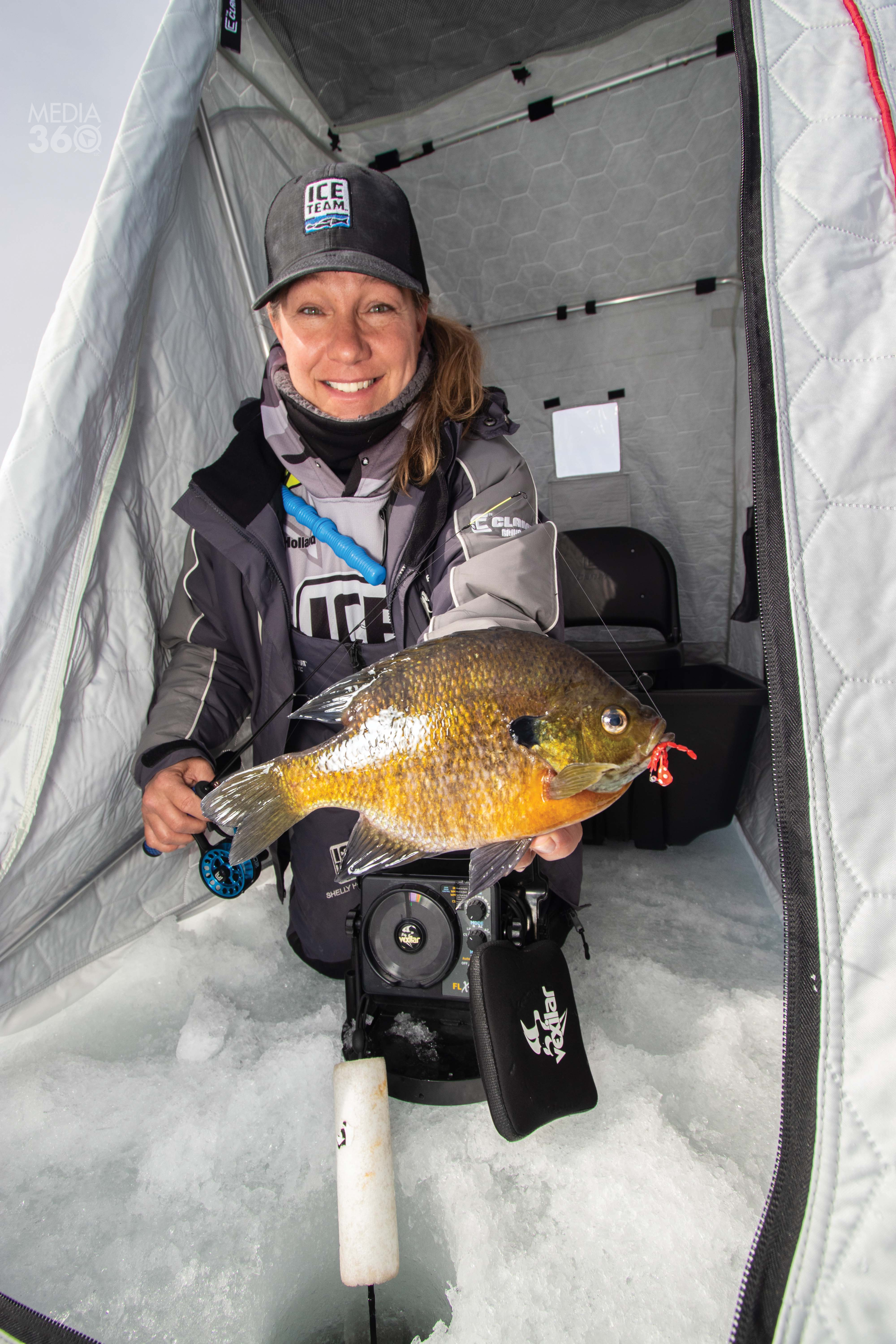Some bluegills and crappies never leave their shallow-water hideouts.
Across the ice belt, crappies and bluegills follow a fairly predictable seasonal transition. First ice often finds fish relating to stands of green weeds or holding off of contours that extend from the basin. Mid-winter might find fish roaming a main basin or holes, often suspending. Late ice often brings shallow bays and flats back to life, particularly if there is flooded vegetation present. Panfish seemingly float from one season to the next following this predictable black book
of addresses.
While these seasonal movements and locations are real, and bona fide starting points for hunting down winter panfish, there are some fish that don’t necessarily follow this time-honored playbook.
A percentage of panfish will remain in shallow water through the darkest days of winter, and in many cases, some of these bluegills and crappies grow to impressive stature.
Time and Pressure
Bluegills and crappies are extremely adaptable. They inhabit an array of ecosystems. Thus, many types of lakes are capable of producing big panfish. But there is one common denominator that all panfish need to reach a respectable size: time.
As anglers, we are the wild card that can alter productive patterns and locations.
Predictable spots often get pressured hard if there is a good population of fish. As a rule, fishing pressure takes out the larger fish and decreases the average size of the fish.
The predictable fish often go home in a plastic pail. And as a result, anglers often have to look for fish and patterns that are overlooked or misunderstood.

On many fisheries, some of the most overlooked or misunderstood patterns occur in less than 5 feet of water. Panfish in shallow water are often overlooked through the doldrums of winter because enough fish suspend over wintering holes to attract anglers. However, there are several triggers that can ignite a shallow-water bite that might produce some of the largest panfish you catch this winter.
Cutting the Weeds
Dense weeds, whether they are coontail, cabbage or a mixture of several varieties, often require some adjustments in gear. One of the most effective tactics to cut through the vegetation is to increase the size and weight of the ice jig.
Anglers often use a compact horizontal jig with enough weight to drop through the stems and leaves. My favorite jig for this type of application is a Northland Mud Bug. Don’t go overboard, though. Just step up a size or two larger than what you might normally use to finesse fish in open water.
Another tip to make the jig fall through the water more quickly is to use a flourocarbon leader. Fluorocarbon is heavier than monofilament, so it sinks.
Lessons in Snow
Extremes in snow cover often create strong shallow-water bites for crappies and bluegills — but the reasons contrast sharply.
A lack of snow often accelerates weed growth through winter. Light isn’t as limited, and the browning stands of weeds from fall green up and begin to rejuvenate.
Shallow weeds are typically one of the first and most productive locations anglers will target at first ice. But when there is no or little snow, and sunshine can penetrate the ice, this productive early-ice location can often kick out fish through winter. Or, at least until fishing pressure catches up with the spot.

Yet, even if pressure is constant, many anglers will focus on the obvious outside edges and easy-to-find lanes, ignoring the inside edge of the weeds.
Anglers also have a tendency to ignore the vertical openings sometimes found where the weeds are dense and difficult to fish.
Small openings in dense weeds are created by objects on the lake bottom that inhibit weed growth. These small openings might only hold a handful of fish, but they are often bigger fish.
The opening could be an old tire from a rollout dock, or a rock or bicycle. Just look for something hard that will create an opening above the object.
Mark these hard spots during the open-water season using a GPS. If you’re using a boat-mounted GPS, be sure to have the GPS antenna as close to the object as possible. This attention to detail during open-water recon efforts will get you close enough so you can find the spot by drilling a few holes.
Deep Snow Means Go Shallow
Conversely, a hard winter with heavy snow cover cuts down light penetration and the weed growth that needs light to flourish.
Yet, during winters with brutal snow conditions, we also often find fish in extremely shallow water — but for different reasons.
When oxygen levels in a lake decrease to the point where the fishery is stressed, fish often do a couple of things. First, they rise and ride high in the water, often right below the ice. Second, they often stack up tight to a shoreline if there is any kind of a feeder creek or spring that can trickle water into the lake.
Obviously, feeder creeks and springs can create dangerous ice conditions, so beware of these areas. However, if safe conditions exist, fish where you can find good ice near a creek or spring along the shore. Many of these areas are visible, because water seeping into the lake stains the snow and ice near shore yellow or brown.
When fish become stressed, they seek these locations regardless of pressure. If the lake is on the verge of winter-killing, fish will tilt with their lips up and swim around less than an inch from the ice, sometimes actually swimming up the hole. However, when they get to this point, they typically don’t bite and can be hard to catch.
Lucking Into Fish
So often when targeting panfish, most of the population will follow a particular program. This program will attract most of the angling effort.
Yet, despite the standard patterns, there are usually some fish using a different and often overlooked niche. Often, this little wrinkle lets these fish live long enough to get big. Through the years, I have encountered several interesting patterns where I found impressive crappies and bluegills in a few feet of water under the ice.
Often, I merely stumbled into these fish, and it took a while to put together the pieces of the puzzle to determine why they were using these locations.
Usually, but not always, vegetation — green aquatic or flooded terrestrial vegetation, such as reeds, cattails or timber — was a factor. Of course, I have also found fish in shallow water during the dead of winter on featureless bowl lakes with stained water.
Stealth is Critical
Regardless of why some fish don’t slide out into the basin or suspend over a hole with the masses, one aspect of fishing shallow water has a reoccurring theme — fish in shallow water often spook much easier and are much less tolerant of angling pressure. They have to be approached with more care.

Commotion such as stomping boots or vehicles driving up seems to cool off shallow spots, and crowds don’t often bode well for shallow-water bites.
Many shallow locations are most productive if you are fishing them alone or in small groups.
Even if you’re alone, stealth can be helpful. In regions of Illinois, Indiana and Iowa, some anglers have gotten into the habit of using longer rods so they don’t have to walk directly to the hole. The idea is that boot noise moves the fish around.
With this in mind, I helped Clam Corp. develop a 48-inch rod in the popular Meat Stick series. These rods are branded as the Jason Mitchell Elite Series.
Watch it Happen
One advantage to shallow water is the opportunity to close out the light and watch what the fish are doing. If water clarity permits, sight-fishing inside a dark house is not only a great education, it provides a level of entertainment. More important, it lets you refine the presentation when triggering difficult fish.
Many good ice anglers have gotten into the habit of wearing dark clothes that match the interior of the dark house. Some anglers go so far as leaving some slush in the hole to mask movement. The jury is still out for me. I can’t tell if these extra precautions let me consistently catch more fish. It can’t hurt.
Also, although many panfish anglers are using a 4- or 6-inch auger, a 10-inch hole is better for sight-fishing. The larger hole lets you look to the sides much better and see fish coming from farther away without having to get directly over the hole.

If there is a disadvantage to using a 10-inch bit, it is the increased weight and the fact that 10-inch augers are uncommon enough on many lakes that people can quickly figure out where you have been.
Timing the Bite
Although strong shallow patterns can show up all winter, time of day can still be an important factor.
More often than not, early mornings and evenings see the most fish movement.
During low-light conditions, many fish — bluegills and crappies included — often seem more comfortable and cruise through areas.
This means fish will often come to you, and spots will often “recharge” with new fish. These fish essentially take the place of the fish you are catching.
As the sun climbs higher, the fish cruise less, and anglers must move and fish more aggressively to keep contacting panfish that tend to hold in pockets or near some type of cover.
Time of day and the correlating intensity of fish movements should play a critical role in determining your strategy.
— Jason Mitchell is a fishing and hunting guide on North Dakota’s Devils Lake. Check out his website, JasonMitchelloutdoors.com, and his television show, Jason Mitchell Outdoors on Fox Sports Net North and Midwest.


